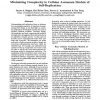Free Online Productivity Tools
i2Speak
i2Symbol
i2OCR
iTex2Img
iWeb2Print
iWeb2Shot
i2Type
iPdf2Split
iPdf2Merge
i2Bopomofo
i2Arabic
i2Style
i2Image
i2PDF
iLatex2Rtf
Sci2ools
119
click to vote
ISMB
1993
1993
Minimizing Complexity in Cellular Automata Models of Self-Replication
Understanding self-replication from an information processing perspective is important because, amongother things, it can shed light on molecular mechanismsof biological reproduction and on prebiotic chemical evolution. Intuition, biological knowledge, and early computational models of self-replication all suggestedthat self-replication is an inherently complex process. In this paper we describe recent computational studies that challenge this viewpoint. Wesummarize our recent workwith cellular automata models of simple yet non-trivial self-replicating structures called unsheathed loops. For example, one unsheathed loop consists of only six componentsand requires only 20 rules to specify the local intercomponent interactions needed to bring about replication. The implication of this workis that, whenviewedas an emergent property of numerous local, concurrent interactions between components,self-replicating systems can be substantially simpler than is generally recognized.1 Developingm...
Computational Biology | Computational Models | ISMB 1993 | Non-trivial Self-replicating Structures | Self-replicating |
Related Content
| Added | 02 Nov 2010 |
| Updated | 02 Nov 2010 |
| Type | Conference |
| Year | 1993 |
| Where | ISMB |
| Authors | James A. Reggia, Hui-Hsien Chou, Steven L. Armentrout, Yun Peng |
Comments (0)

